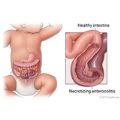Necrotizing Enterocolitis
Topic Overview
What is necrotizing enterocolitis?
Necrotizing enterocolitis is infection and inflammation of the intestine. It is most common in babies who are born early (premature). Many newborns who have it go on to live healthy lives. But if the infection becomes severe, it can cause severe damage to the intestine, which can be deadly. Some children may have ongoing problems with digestion, growth, or development.
This condition usually happens within the first 2 weeks after birth. But it may occur up to 3 months after birth.
What causes necrotizing enterocolitis, and can it be prevented?
Doctors aren’t sure what causes this condition. It may occur when the immune and digestive systems do not form in the right ways. This can happen when a baby is born early or when there are problems during pregnancy or delivery.
Experts don’t know if feeding formula to a newborn can lead to necrotizing enterocolitis. They do know that the disease is much less common in babies who are fed breast milk.
Some doctors recommend probiotics to help prevent necrotizing enterocolitis in some infants who are at risk for it. Probiotics are bacteria that help maintain the natural balance of organisms (microflora) in the intestines.
What are the symptoms?
Symptoms depend on how severe the problem is. They may include:
- A swollen, tender, red, or shiny belly.
- Constipation.
- Dark, black, or bloody stools.
- Low or unstable body temperature.
- Chills and fever.
- Fast heartbeat and breathing.
- Not wanting to eat.
- Vomiting.
- Being less active or having little energy.
How is necrotizing enterocolitis diagnosed?
The doctor will ask about your baby’s symptoms and past health. The doctor may do tests, such as:
- An X-ray of your newborn’s belly.
- A test to check for blood in your baby’s stool (fecal occult blood test).
- Tests to check for bacteria in the stool, blood, urine, or spinal fluid.
How is it treated?
Your baby will be treated in a hospital neonatal intensive care unit (NICU). Treatment usually lasts 3 to 10 days. It may last longer if the condition is severe. Treatment includes intravenous (IV) feeding, antibiotics, and a tube that goes in the nose to the stomach to remove extra fluids and gas from the intestine.
If your baby does not get better with treatment or gets a hole in the intestine, he or she may need surgery. About 1 out of 4 babies who have necrotizing enterocolitis may need surgery.footnote 1 Surgery usually means having two procedures weeks or months apart. The first surgery removes damaged parts of the intestine and may create a colostomy or ileostomy so that the intestine can heal. (With an ostomy, stool leaves the body through an opening in the belly and collects in a bag.) A second surgery will be done to close the ostomy so that stool can pass through the body normally again.
After treatment, your baby will be ready to leave the hospital when he or she is eating well and is not losing weight. The nurse can show you how to feed and care for your baby at home.
It is normal to feel overwhelmed when your baby has health problems. It can be stressful to watch a tiny newborn get medical treatment. You may feel frustrated if you can’t hold your baby as often as you want or can’t breastfeed your baby. It may help to talk about your feelings and concerns with a social worker or counselor. Be sure to ask your baby’s doctors about anything you don’t understand.
References
Citations
- Rosenburg A, et al. (2014). The newborn infant. In WW Hay Jr et al., eds., Current Diagnosis and Treatment: Pediatrics, 22nd ed., pp. 9–74. New York: McGraw-Hill.
Other Works Consulted
- AlFaleh K, et al. (2011). Probiotics for prevention of necrotizing enterocolitis in preterm infants. Cochrane Database of Systematic Reviews (3).
- Brown RE, Neu J (2006). Necrotizing enterocolitis. In FD Burg et al., eds., Current Pediatric Therapy, 18th ed., pp. 293–296. Philadelphia: Saunders Elsevier.
- Maheshwari A, Carlo WA (2011). Neonatal necrotizing enterocolitis. In RM Kliegman et al., eds., Nelson Textbook of Pediatrics, 19th ed., pp. 601–603. Philadelphia: Saunders.
- Necrotizing Enterocolitis (NEC) Guideline Team, Cincinnati Children’s Hospital Medical Center (2010). Evidence-Based Guideline for Necrotizing Enterocolitis Among Very Low Birth Weight Infants. Guideline No. 28. Available online: http://www.cincinnatichildrens.org/service/j/anderson-center/evidence-based-care/necrotizing-enterocolitis.
- Pammi M, Abrams SA (2011). Oral lactoferrin for the prevention of sepsis and necrotizing enterocolitis in preterm infants. Cochrane Database of Systematic Reviews (10).
- Pammi M, Abrams SA (2011). Oral lactoferrin for the treatment of sepsis and necrotizing enterocolitis in neonates. Cochrane Database of Systematic Reviews (10).
- Solomkin JS, et al. (2010). Diagnosis and management of complicated intra-abdominal infection in adults and children: Guidelines by the Surgical Infection Society and the Infection Society and the Infectious Diseases Society of America. Clinical Infectious Diseases, 50(2): 133–164. [Erratum in Clinical Infectious Diseases, 50(12): 1695.]
Current as of: December 12, 2018
Author: Healthwise Staff
Medical Review:Sarah A. Marshall, MD – Family Medicine & John Pope, MD, MPH – Pediatrics & Kathleen Romito, MD – Family Medicine & Brad W. Warner, MD – Pediatric Surgery, Critical Care Medicine
This information does not replace the advice of a doctor. Healthwise, Incorporated, disclaims any warranty or liability for your use of this information. Your use of this information means that you agree to the Terms of Use. Learn how we develop our content.


